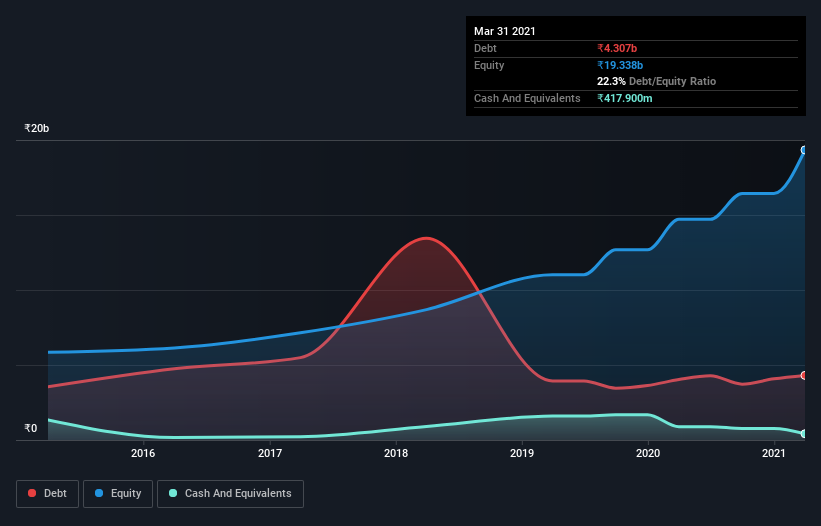
Warren Buffett famously said, 'Volatility is far from synonymous with risk.' It's only natural to consider a company's balance sheet when you examine how risky it is, since debt is often involved when a business collapses. We note that Adani Total Gas Limited (NSE:ATGL) does have debt on its balance sheet. But the more important question is: how much risk is that debt creating?
Why Does Debt Bring Risk?
Debt and other liabilities become risky for a business when it cannot easily fulfill those obligations, either with free cash flow or by raising capital at an attractive price. Ultimately, if the company can't fulfill its legal obligations to repay debt, shareholders could walk away with nothing. While that is not too common, we often do see indebted companies permanently diluting shareholders because lenders force them to raise capital at a distressed price. Having said that, the most common situation is where a company manages its debt reasonably well - and to its own advantage. When we examine debt levels, we first consider both cash and debt levels, together.
View our latest analysis for Adani Total Gas
What Is Adani Total Gas's Debt?
The image below, which you can click on for greater detail, shows that at March 2021 Adani Total Gas had debt of ₹4.31b, up from ₹4.03b in one year. However, it does have ₹417.9m in cash offsetting this, leading to net debt of about ₹3.89b.

How Strong Is Adani Total Gas' Balance Sheet?
Zooming in on the latest balance sheet data, we can see that Adani Total Gas had liabilities of ₹8.08b due within 12 months and liabilities of ₹4.62b due beyond that. Offsetting this, it had ₹417.9m in cash and ₹1.04b in receivables that were due within 12 months. So its liabilities total ₹11.2b more than the combination of its cash and short-term receivables.
Having regard to Adani Total Gas' size, it seems that its liquid assets are well balanced with its total liabilities. So it's very unlikely that the ₹1.38t company is short on cash, but still worth keeping an eye on the balance sheet. But either way, Adani Total Gas has virtually no net debt, so it's fair to say it does not have a heavy debt load!
We measure a company's debt load relative to its earnings power by looking at its net debt divided by its earnings before interest, tax, depreciation, and amortization (EBITDA) and by calculating how easily its earnings before interest and tax (EBIT) cover its interest expense (interest cover). Thus we consider debt relative to earnings both with and without depreciation and amortization expenses.
Adani Total Gas has a low net debt to EBITDA ratio of only 0.52. And its EBIT easily covers its interest expense, being 17.0 times the size. So you could argue it is no more threatened by its debt than an elephant is by a mouse. Another good sign is that Adani Total Gas has been able to increase its EBIT by 26% in twelve months, making it easier to pay down debt. When analysing debt levels, the balance sheet is the obvious place to start. But it is Adani Total Gas's earnings that will influence how the balance sheet holds up in the future. So when considering debt, it's definitely worth looking at the earnings trend. Click here for an interactive snapshot.
Finally, a company can only pay off debt with cold hard cash, not accounting profits. So we clearly need to look at whether that EBIT is leading to corresponding free cash flow. In the last three years, Adani Total Gas created free cash flow amounting to 10% of its EBIT, an uninspiring performance. That limp level of cash conversion undermines its ability to manage and pay down debt.
Our View
Happily, Adani Total Gas's impressive interest cover implies it has the upper hand on its debt. But we must concede we find its conversion of EBIT to free cash flow has the opposite effect. We would also note that Gas Utilities industry companies like Adani Total Gas commonly do use debt without problems. Looking at the bigger picture, we think Adani Total Gas's use of debt seems quite reasonable and we're not concerned about it. While debt does bring risk, when used wisely it can also bring a higher return on equity. When analysing debt levels, the balance sheet is the obvious place to start. But ultimately, every company can contain risks that exist outside of the balance sheet. For example, we've discovered 1 warning sign for Adani Total Gas that you should be aware of before investing here.
When all is said and done, sometimes its easier to focus on companies that don't even need debt. Readers can access a list of growth stocks with zero net debt 100% free, right now.
When trading Adani Total Gas or any other investment, use the platform considered by many to be the Professional's Gateway to the Worlds Market, Interactive Brokers. You get the lowest-cost* trading on stocks, options, futures, forex, bonds and funds worldwide from a single integrated account. Promoted
New: Manage All Your Stock Portfolios in One Place
We've created the ultimate portfolio companion for stock investors, and it's free.
• Connect an unlimited number of Portfolios and see your total in one currency
• Be alerted to new Warning Signs or Risks via email or mobile
• Track the Fair Value of your stocks
This article by Simply Wall St is general in nature. It does not constitute a recommendation to buy or sell any stock, and does not take account of your objectives, or your financial situation. We aim to bring you long-term focused analysis driven by fundamental data. Note that our analysis may not factor in the latest price-sensitive company announcements or qualitative material. Simply Wall St has no position in any stocks mentioned.
*Interactive Brokers Rated Lowest Cost Broker by StockBrokers.com Annual Online Review 2020
Have feedback on this article? Concerned about the content? Get in touch with us directly. Alternatively, email editorial-team (at) simplywallst.com.
About NSEI:ATGL
Mediocre balance sheet with questionable track record.
Similar Companies
Market Insights
Community Narratives



